The Simone Abbarchi workshop, in a little street, outside Florence
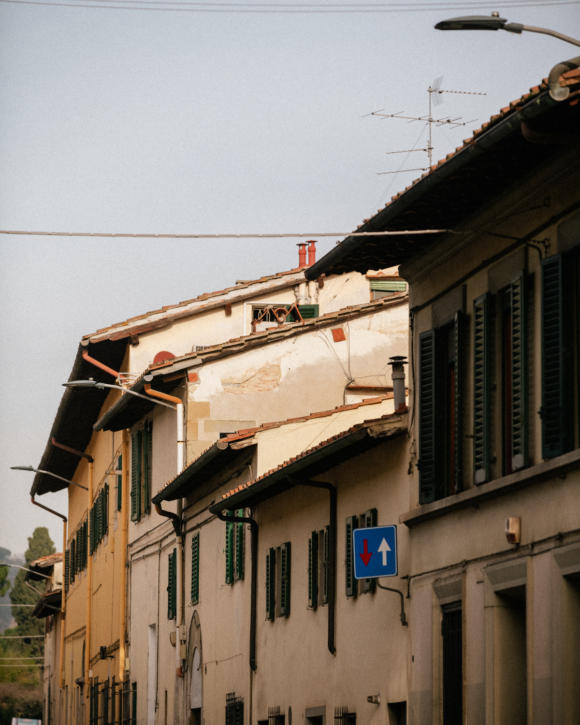
I know shirtmaker Simone Abbarchi has a lot of PS customers in London and New York. They might like to know - and see - where their shirts are made.
It’s a little workshop about 10 minutes drive outside of Florence. Simone arrives every morning at 8:00, and leaves at 1:00 to drive to the shop in town. Most of his appointments are booked for the afternoon.
The street outside is busy, narrow and old, with a narrow little pavement and cars shuttling up and down. The front door opens straight into the workroom.
There, six women are conducting every stage of the shirtmaking process, with roughly one each. In front of us a younger employee is preparing fabric that has come in from Canclini, Thomas Mason and elsewhere. To the left, collars are being cut, then bodies assembled. In the middle, the final product is pressed and folded.
It’s clean, organised and very manual. Everyone knows their place; the process skips along as we watch. But there’s very little automation.
Perhaps the embodiment of this is Simone’s filing system, in his little office behind the atelier. Patterns and records there are organised into binders, which are then allocated to locations. Long-time customers even have their purchases organised into personal binders.
That’s one below, from a particularly long-term client in New York. Each shirt has a little snippet of the cloth beside it, with notes on the style and the fit. “He is always surprised when I know what he ordered, when, and how he has changed,” says Simone.
The makers have been with Simone for varying lengths of the time, with new ones joining as the business has grown. The longest - now in charge of pressing and quality control - was the first employee back in the mid-nineties.
“Over time each has recommended a friend, who recommended another, and they all helped train the new,” Simone says. “It has to be that way, because there’s no shirtmaking school near here. You really only have that for leather in Florence.”
This is in contrast to Naples, where the brands that prioritise handwork in particular - Kiton, Attolini - have their own schools, and there is enough demand that there are dozens of shirtmakers working at home, that work can be sent out to.
D’Avino’s workshop, for example, just outside Naples, is a similar size but surrounded by such workers. Simone needs to be more self-sufficient.
Simone started with shirts out of passion - he had no training, no family members in the trade. He simply loved the style of shirts and found a shirtmaker who could help make them.
Growth has been slow but consistent, always focused on visiting just New York and London. He opened his first workshop in 2000, then the shop in Florence, then this larger workshop in 2012. It’s a solid operation, and one he likes the size of.
Bespoke customers often ask why artisans don’t do more trunk shows when there is demand - why they don’t want the business. The reason is usually that they don’t want to run that scale of operation, because it would change the nature of the job. There would be more time managing people, rather than products; and more time spent travelling rather than in the workshop.
When someone runs a business that was built on passion, they usually don’t want to change the the day-to-day experience of it, because it was the reason they started in the first place.
In Simone’s workshop, the day-to-day life of production continues around us, as we chat.
Alex, the photographer, is busy picking up little details - the kind of things you find in every office or factory, that people add incrementally to their workspaces, adding personality.
He also starts to notice the embroidery on Simone’s shirts, which is impressive for an operation that doesn’t use much hand sewing elsewhere. There are delicate initials, names, and even designs that customers have sketched themselves and sent in. That’s one of them below, with the original drawing alongside the finished result.
There are many pleasures to having your shirts made by an artisan. They include the relationship you establish over time, which would rarely happen with a shop assistant; the personalisation of orders and superior better fit; and the ability to repair or alter the things you have made, making them more long-lasting and sustainable.
But it’s also nice - more human, perhaps - to know they’re made in little workshops like this rather than in a big, volume-driven factory.
You can picture it when you receive your order. You know it’s a little workshop with character and personality, in a busy little street on the outskirts of Florence, where new and ancient buildings rub shoulders, and a little team of six people arrive each day to go through the process of sewing things together for you.
Illustrating that is the greatest pleasure of these factory visits.
Simone Abbarchi offers made to measure and bespoke shirts, with the latter involving more changes to both fit and design. They cost €165 and €210 respectively. He visits London and New York twice a year.
More on him and my reviews of his shirts over the years, here.
Photography: Alex Natt


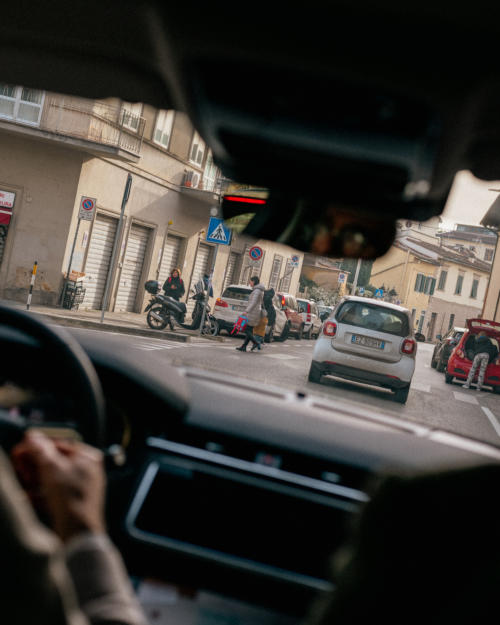
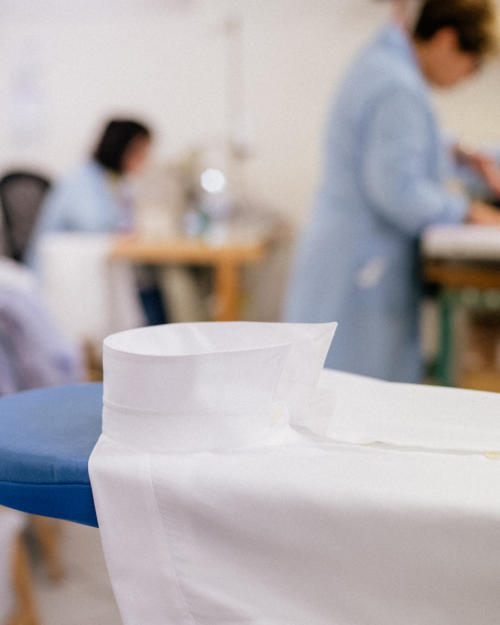
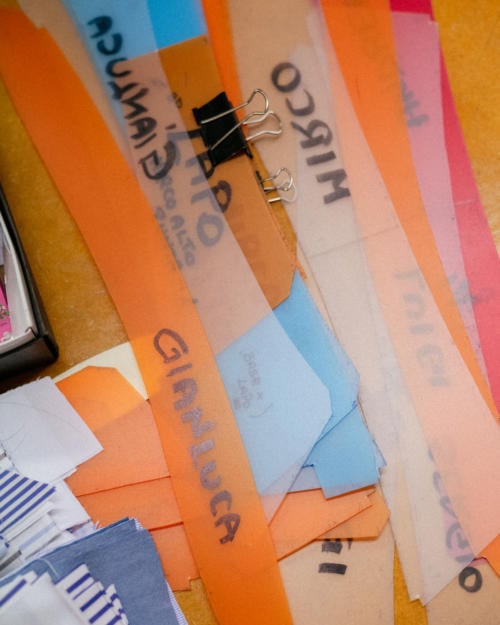
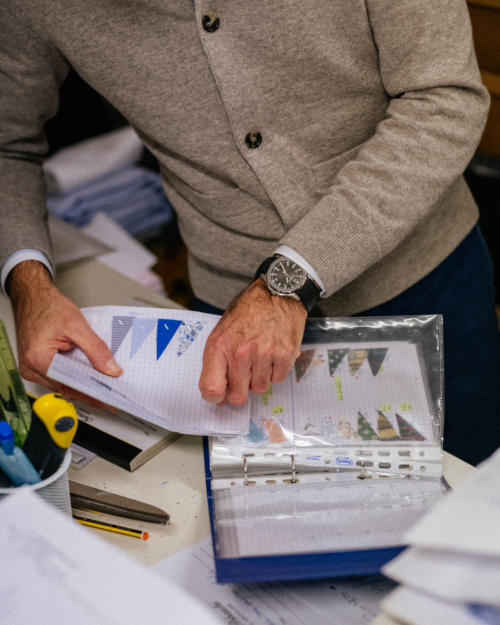
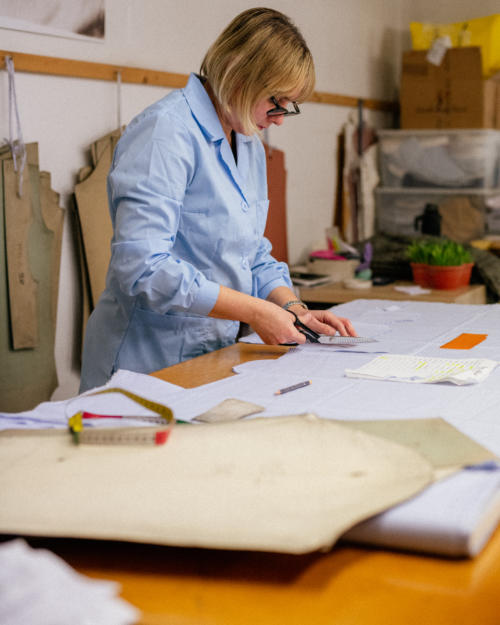
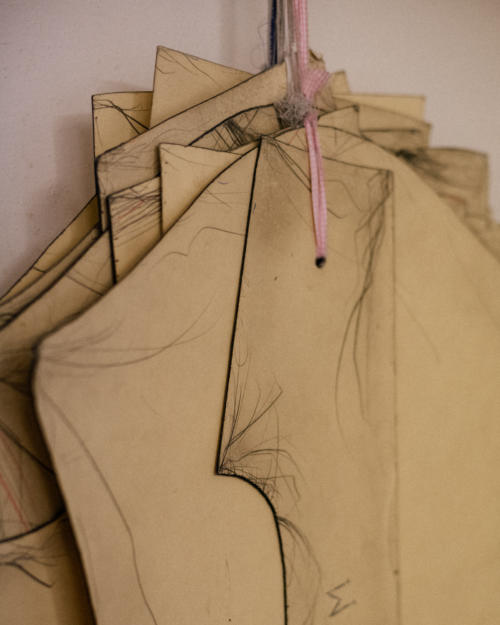
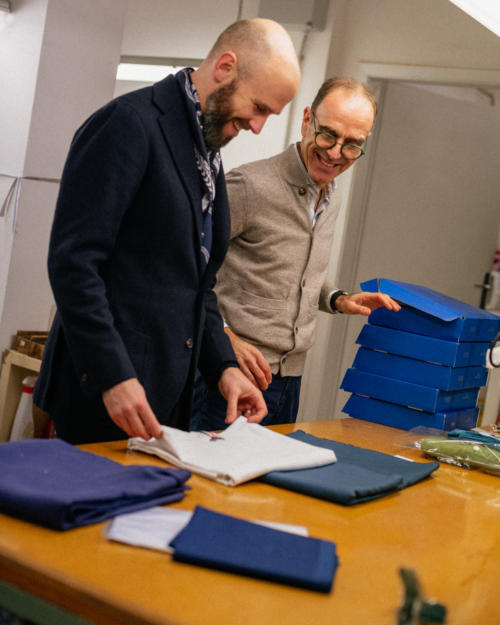
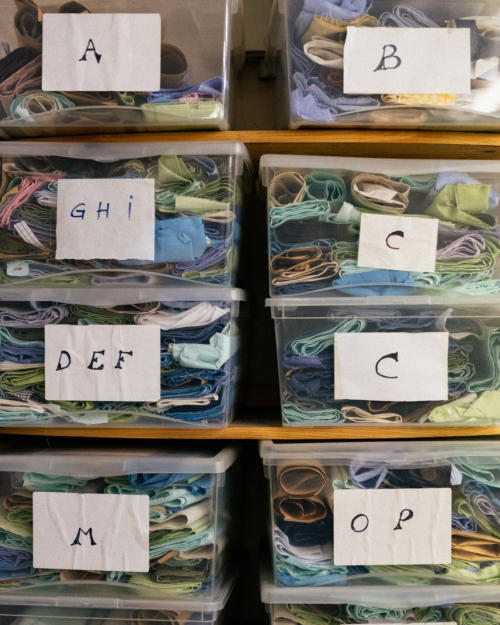
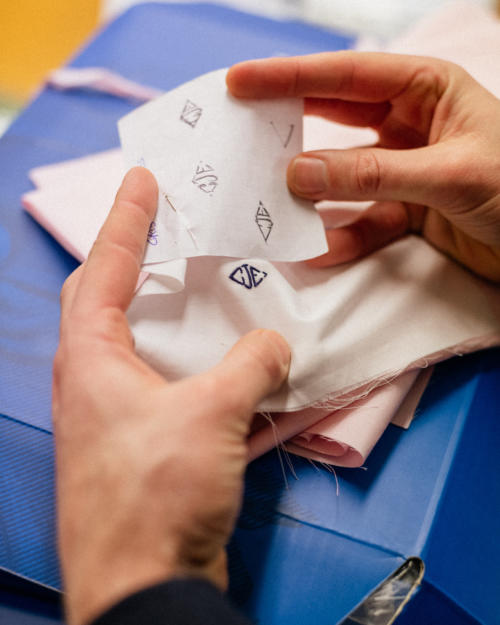
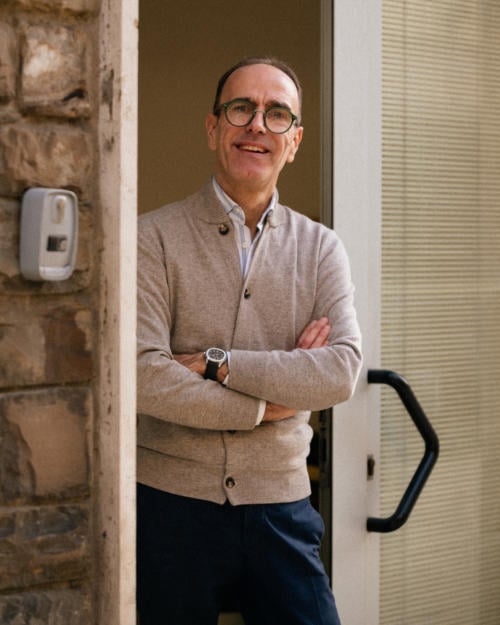
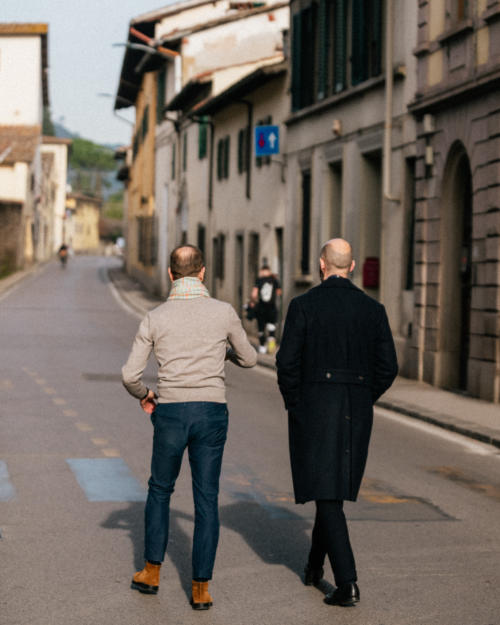


























This wants me to go to Florence and become a customer too. Simon, do you know what cardigan Simone is wearing? It looks great!
I believe it’s one of his own – he does a little MTM knitwear as well, or at least used to. I can check if you’re interested
Simon, Just on the point of visiting him in Florence to order and / or collect shirts … would this result in any saving on customs , VAT ?
Particularly given BREXIT .
No Robin. The Brexit agreement means there should be no customs on ordering from the EU, if the product is of EU origin, as this would be.
And you pay VAT, sales tax, wherever you are – the only difference here would be that you’d pay the Italian sales tax rather than the British.
Congratulations to Mr Abbarchi on his Aquanaut. That reference (5167/1A-001) is one of the most sought after in the Patek Philippe family and as difficult as the Nautilus to acquire. He has worked hard and certainly deserves a watch of that caliber.
Hey Simon,
I don’t think that’s right. I have been paying customs tax and UK VAT on imported goods post Brexit (end of the transition period on 31 December 2020). Some EU brands deduct their VAT from the final price when selling to UK – but you still pay the UK rate.
Either that or FedEx and DHL have been taking me for a ride these past couple of years.
Hey John,
OK, so the thing that matters is not just where the brand is based, but also where the goods were made. The goods have to be of EU origin to not have customs applied to them. So if you buy something from an Italian brand that was made in Italy (or Sweden, or France) it should not have any customs charges when it arrives in the UK. But if it was made in China (or the UK) then it will be charged.
The brand also has to state on its customs forms, however, that the product is of ‘EU Preferential Origin’. Some brands were very slow to start doing this post-Brexit, but I would have thought most would be doing so now.
Finally, please note that customs and taxes are completely separate. You always have to pay taxes (VAT) when you buy something from the EU – you now pay the UK rate rather than the rate of the country you bought it from. But you shouldn’t pay taxes on top of that.
Let me know if you have any other questions
Okay this make sense — really appreciate the detailed response. Although I am sure I’ve been charged customs duty on goods made in the EU (Swedish brands who say their clothes are made in EU counties). I have on several Berg & Berg and Rubato orders for example.
I’ll keep my eye on this going forward. I was always an ardent remainer, but getting the menswear bug has given me even more reason to regret the 52%’s decision. Although let’s not get into that here.
Absolutely! With you but not the right forum.
Rubato is not made in the EU – it’s made in the UK or in Japan mostly, so that would explain that? Not sure where Berg is made these days, but I think they moved some of it.
Hey Markus – I checked and no, he doesn’t offer the knits any more
Thank you, Simon. What a pity.
Was it hot or cold that day! Overcoat vs cardigan?
Simone’s coat was in the car
What a coincidence! I just booked an appointment with him! And at least when booking, he was way way more responsive than my experience was with luca. Lets see how it goes! Since its made to measure i think i can show him 2 shirts i like and say something along the lines, i cant wear smaller chest like this, but i really dont want any bigger than this. Anything in the middle im happy to leave to you.
Fascinating article and lovely pictures. I almost wish there was a diagram showing the various stages as a shirt moves around the atelier from the receipt of cloth to the boxing and shipping. But maybe that would take away some of the magic?
A great read for Friday. Thanks.
I know this is about the shirts, but Simone is very well dressed here. Simply but well.
Thanks for the article Simon. Always nice to know what happens behind the scenes.
Simone is simply one of the most enthusiastic and lovely people you would ever come across. I’m can’t imagine using anyone else.
Simone is a very nice guy and his work in Italian can be summarize with “niente fronzoli e tanta sostanza”.
I am a relatively recent customer, and I will continue, price quality ratio is very high (in Europe)
Thanks, I’m translating that as ‘no frills but lots of substance’? Just to save everyone heading to Google Translate!
Grazie 😉
Ive had shirts from Simone a couple of times. He’s a very nice man, very friendly and courteous. I would say though that their first attempt was very slim fitting in all aspects. I often find this to be the case with italian makers. They seem to want to give you the slimmest possible fit. So beware any starting out with Simone if this is not what you want. Ultimately i have found though that although very well priced these shirts are comparable to RTW but perhaps without the design benefits you get from RTW brands. I am a fairly normal shape and size so finding well fitting RTW is not a problem and as with many MTO makers the cloth selection is more suited to business shirting.
I normally yawn a little when I open PS and see it’s a factory visit you’ve written about but this one I really have a personal interest in .
I started using Simone several years ago after hearing about him through PS .
It was my first jump into MTM and a real mind shift away from cheap , low quality clothing .
Since then I’ve been back every year and await eagerly the arrival of new shirts.
It doesn’t matter what you plan on buying the minute you see Simone and his colleague you think “Damn ! I want what they’re wearing !”
Simone and his friend greet you with a warmth and familiarity of an old friend .
I learnt to allow the maestro to guide me on collar styles etc (trust me the guy knows what suits you).
You walk out 20/30 minutes later , down several hundred £ feeling like you’ve been in their company longer then you really have and with a big smile .
It’s an extraordinary experience .
I finally understand what “service” means .
You may buy cheaper but the combination of the quality of the cloth , the collar shape and the MTM means you won’t get the same value anywhere .
Trust me I’ve tried .
P.S. how does he keep so trim living in the country that gave us pasta !
Pleased to hear it Robin. Simone’s colleague is Gianluca by the way, he manages the shop in Florence and is there in the morning when Simone is at the workshop.
Do shout if there’s anything you think would add interest to a factory visit when it’s not someone you use – there are always so many different angles you could take with these pieces.
I really enjoy these. The only thing I would like to understand more about is the design process and why they chose their designs -tradition, cloth machinery,workforce etc.
Please continue these. It’s vital we maintain the human interaction .
Nice to hear Peter, and thanks, noted
I think this is more of interest because I use Simone .
I think what this article really helps me appreciate is the exclusive ‘small’ operation he runs and therefore understand more the cost of what I pay for .
OK, good to know Robin
Apologies for the off-topic comment, but that is quite the beater watch Simone is wearing.
This reminds me of a time a few yeas ago when one the guys who painted the exterior of our building drove a Porche Cayenne. Good for him–everyone deserves success. I couldn’t help but wonder nontheless whether we were being overcharged…
He might sold his AP RO which he had for years (before the hype which speaks to his taste) and therefore payed way less than what they cost today and flipped it into a Patek. Or maybe he had the possibility to buy it from an AD because he is a nice guy. We don‘t know the story so why not just admire his piece?
Also your painter might made his Porsche money by buying and owing real estate, stocks or more foolishly cryptos and not painting buildings. Or he sinks all his money into his car. We don‘t know the story.
Hilarious, was thinking the same thing. Beautiful beater.
Hi Simon,
Do you know if Simone has a minimum order for first time clients? I know many shirt makers say you must order 3/4 shirts to begin with?
Good point, I’m not sure as it’s been a while for me. Let me check
A few days ago I’ve scheduled a first-time appointment with Simone for early May. No minimum order. But also, Simon, he did say 240 euro for bespoke, not 210.
OK, thanks Robert. Maybe there’s been a slight increase since last year. It’s not his fault, costs are going up everywhere, from the raw material to spinners to the weavers to the makers
Oh yes, that’s well understood. It wasn’t my intention to blame him, just wanted to give up-to-date information.
Absolutely, sorry I didn’t mean to suggest you were doing that either!
I’m not sure what he will say in person but when I asked over email, can I order just 1 shirt he said ok, we can do it.
also when I asked can he do cut to measure, he quoted me “about 140€”
I always considered a bit silly when you have to order multiple shirts (and get them all at the same time!) I’d rather stick to rtw than risk getting 2-4 unwearable shirts second time. 150£ adds up to a lot when you have to pay for more than one shirt at once.
Hi Jonny, no Simone does not
Hilditch & Key’s shirts, following the closure of the Glenrothes factory, are now made in Bergamo. IMO the quality has declined and prices have rocketed so I am looking for a new shirtmaker whose prices are reasonable.
Does Simone make MTM and bespoke shirts with English plackets rather than French fronts? I prefer the former with a point collar and wondered if Abbarchi is worth trying.
As Bergamo is renowned for its shirt factories and makers, I would appreciate any recommendations of affordable brands that are based in the town.
Yes, Simone makes shirts with plackets
Hi Simon,
I really enjoy this type of article and this one was no exception. Great to see and gain an understanding of a thriving small/medium enterprise that employs locally and would I believe contribute to the local economy. More power to Simone and long may his success continue.
Enjoyed the profile of this workshop.
I look forward to future pieces about factories.
Thank you, and great suggestions.
On the second one, the only thing is these are the same in every shirt workshop! But having said that, I’m not sure I’ve done it before with shirts, so could definitely do that once at least.
Hi Simon
Great article. Do you know what Simone charges for customer supplied cloth, such as PS oxfords or chambray?
See above from Martins in the comments Omar
I am a client of Abbarchi, ordered many shirts over the years and kept ordering until not long time ago.
The quality has dropped horrendously.
It’s not the product I’d suggest, problems occur here and there over and over again with each order.
Beware.
Hi L – could you be more specific with the problems you had? It seems a little of keeping with my experiences and those of the other commenters on here.
Thank you
Hi Simon,
I’ve had various problems in orders of last year, with double cuffed shirts hard pressed leaving a visible line, that is not possible to remove through flat ironing, buttonholes going undone after first wash, or collars and cuffs fusing collapsing. Simone was taking shirts back to resolve the issues, sometimes twice (due to problem remaining after supposedly being resolved).
The collapse of quality began after Covid, either cutting costs or taking too much orders.
So I stick with other makers now.
Thank you L, that’s very helpful.
I have to say I haven’t experienced anything like that myself, but I’m always aware I might be a special case. Open to hear of anyone else’s experiences as well.
That’s why I wanted to share my experience because I found out about Abbarchi’s operation through Permanent Style and my experience wasn’t as good as covered here, so I felt my feedback was needed for community.
BR,
L
Thank you, yes it’s always useful
I’ve had a shirt made by Simone from when he was starting around 20 years back, which, apart from being a little less refined in its finishing on the sleevehead, has had no quality issues at all.
Like others mentioned, I’d say a strong point of Simone is getting the collar ‘just right’ for you. I’d also hasten to add his warmth and very welcoming nature do make you want to have your shirts made with him.
Last I corresponded with him in Nov, he mentioned he was coming to London this February. I’m not sure if that has changed given the lack of mention in your article, Simon.
No he is Julian, good point. I’m seeing him on Feb 23rd
I’ve been ordering from Simone for about the past 7 years. I’ve not noticed any change in quality.
I have two shirts in the mail right now, a denim shirt and tuxedo shirt, and I am more than confident that they both will be just as excellent as all the other Abbarchi shirts I’ve ordered over the years. I think the opposite is actually true, Simone’s shirts have actually have gone up in quality with the tiny details I have noticed over time.
Hi Simon: Wonderful article as usual. Could you please provide some details on the overcoat you are wearing – the last picture when you seem to be out on a stroll with Simone. Thanks
Thanks Zubair.
Article coming soon on that actually, I’ll leave details til then if that’s ok.
Is he rocking a Patek Aquanaut? Fire
Simon,
Another wonderful description of the benefits and joy of having a relationship with an artisan. The last few paragraphs in the final section summed it up beautifully. I used to use Simone years ago and switched to Luca A. Back then Simone didn’t offer bespoke. Excluding price, how would you compare both offerings. One thing for sure is that they are both incredibly nice people, produce beautiful shirts and are fun to work with.
Enjoy your weekend.
True. The difference is mainly the handwork and the frequency of visits I think. Luca always uses handwork like hand-attached collars, sleeves, hand-sewn buttonholes and so on. Simone does not. Luca is here every couple of months, Simone only every six. But Simone is very reliable in my experience and good at communication
Hi Simon. Many thanks for an excellent article! I read somewhere that Simone can make shirts with (at least some) handwork for an extra charge? Do you know if that is possible and if so, also with MTM?
Good point, he did used to yes. Let me check that too!
Think you’ve done a similar article on D’avino’s workshop. Would be great to see one on Luca Avitabile’s workshop as well to round out the trio.
Already in the works Neil! Thanks for the prompt
Great article and just on time since im looking to find or make a heavy cream shirt. May i ask something irrelevant ? I want to replace my everyday down jacket cause a big hole destroyed it completely at once. I dont want a down style anymore but id like a hardwearing jacket that can work mainly casual. What brands would you suggest to look at ? I must also say that im not such a big fan of army jackets-coats.
What kind of length do you like Georgios? How about shearling?
Id like something short. I have a shearling coat and i wear that all the time but its for a bit colder weather.
How about a pea coat, or the bridge coat we do?
This was a pleasant article and I share the sentiments you expressed in its final part.
Since it has been part of the articles tone, I’d like to ask how do you personally distinct an artisanal workshop/atelier from manufacture/factory? While this probably isn’t overly important question and one can usually intuitively figure it out by scale, is there a specific point you feel a workshop graduates into a factory?
Historically a factory formed when multiple artisans converged in a single workshop to share tools and materials. Later production steps were divided between specialised workers for simplification and speed. These days most artisanal workshops divide the production of single item between multiple specialised workers and there are only very artisans who do everything by themselves.
I’ve had some thought on this matter in past and feel like you could consider three factors: amount of workers, method of production and total output. Still it remains a bit obscure, for example a fully automated and highly efficient production line with 10 operators could have output of 200 workers who are hand making everything.
It’s a good question, m. Probably a hard topic to get into in any satisfying depth in the comments section, but I’d make two comments:
– Dividing production into different steps I wouldn’t say is relevant. The best bespoke in the world sometimes works in that fashion.
– Key I think is flexibility. The larger production gets, the harder it is to change little things on a product, because it affects efficiency so much. This tends to mean the product is much more uniform, with little room for experimentation, personalisation, creativity
Thanks for answering and I think you are right, that seems like a good indicator. While as always there are exceptions, it seems generally as organisation expands and moves towards more planned production/service in scale, it becomes less interested in adapting to individual clients specific wants and needs.
I feel that having have an item made just for me holds some inherent value, makes it feel a bit more special, be it grandmas knit or top bespoke. Like you wrote it’s a bit more human.
Great to have a look behind the scene. Visit him and make an appointment is definitely on my list during next time being in Tuscany. His long sleeved polo shirt is one of my favorite items.
After re-reading the article, I have one question – sorry really a string of questions concerning the business of shirt production.
You write that there is not a lot of handsewing. Do you mean by „handsewing“ actually a person with a needle and without a sewing machine or a person with a sewing machine but no automated production line?
If the first, what is the advantage of handsewing? Surely, a sewing machine is more than a person, or am I wrong.
I buy my business shirts (poplin or twill, nothing fancy, white or light blue) with Eton, Stenströms or Mazzarelli costing around EUR 130-170 a piece thus not much cheaper than e.g. a Luca A. RTW shirt at EUR 200. At least Eton prides itself producing in a high tech factory in Romania. My question, how can a RTW shirt from Simone A. or Luca A. have the same or even better quality when e.g. Eton can use economics of scale producing in a country where labour costs are cheaper than in Italy (Eton in Romania and Stenströms, I believe, in Lithuania)?
– I mean someone with a needle and thread. See here for details on what handwork like that can go into a shirt
– On Eton, largely the type of company they are. They have physical shops, staff, marketing budgets
Hi Simon
I was looking for some help, im thinking of getting a bespoke shirt made by Simone Abbarchi, I have used Luca avitable but wanted to try someone else too. Who would you recommend out of the two and what are the main differences between them?
Also what do you think of Simone Abbarchi MTM service and fit? Would you recommend MTM or bespoke?
Hey F,
I’d suggest having a read of this article from a few years ago where I compare the two of them, and D’Avino. Other than the prices going up a bit with all of them, the analysis is the same.
I’d then recommend reading my review of Simone’s first shirt for me, here.
I think the points about MTM v bespoke are answered in there and in my first, general article on Simone here.
Hi Simon, very nice article and good to see Simone’s operation. I have used Simone twice now, after learning through PS and visited his shop in Florence when passing through last September.
My experience has been very, very good. He responds timely and does follow up, asks how do you like the shirt and fit and if any requirements needed…
I haven’t used Luca or other shirtmakers so can’t have a direct comparison but if I am not wrong on price at least, Luca is about 55-60% more expensive. Personally I am not too fussed if my button holes are done by hand or machine and same goes for the collar.
As you often mentioned, fit is the main thing and collar is most difficult to get right and he has great collars, a few that work with or without a tie.
I have read a few people feeling anxious about ordering bundles, but if you really want to be sure about the perfect fit, order just 1 (i started like this, he has no minimum order), than on the second visit they adjusted it and you get the perfect fit. A bit of patience pays off.
He is very nice guys so is his colleague Gianluca and both speak good english so easy to communicate.
My experience for price and shrive has been excellent and i will be seeing him again in London in couple fo weeks.
Thank your for this view behind the curtains! I like the trend the people want to know how and were their clothed are made. Too long we just thought about styling – and too less about the conditions behind it.